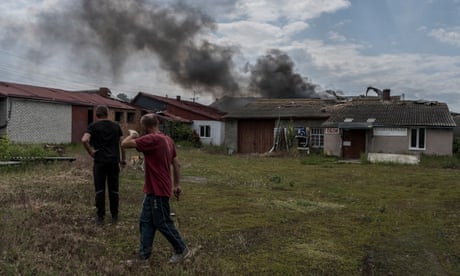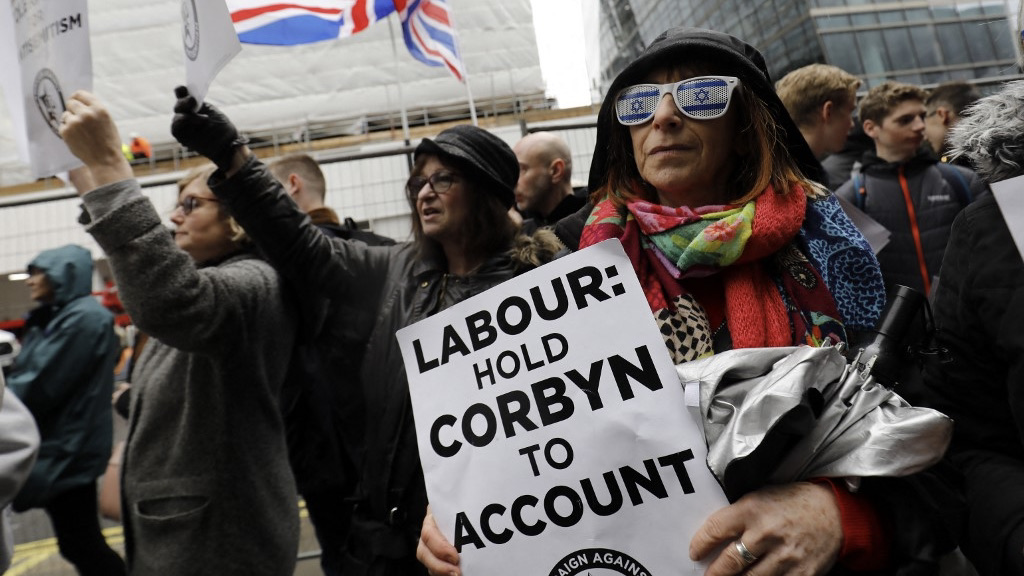Thousands flee homes as collapse of dam is blamed on Russian forces
Ukrainian authorities call for people living downstream of Nova Kakhovka dam to evacuate in face of potentially deadly flooding
Thousands of people have been forced to flee their homes and an ecological disaster has been unleashed on southern Ukraine by the collapse of a major hydroelectric dam on the Dnipro River, which Kyiv said was blown up by Russia in a desperate attempt to ward off a Ukrainian counteroffensive.
Ukraine’s president, Volodymyr Zelenskiy, declared the destruction of the Nova Kakhovka dam as an act of terrorism and the “largest man-made environmental disaster in Europe in decades”.
He blamed Russian occupying forces, which have had control of the dam and the adjacent town since last year’s full-scale invasion. “It is physically impossible to blow it up somehow from the outside, by shelling. It was mined by the Russian occupiers. And they blew it up,” Zelenskiy said on Twitter.
Aerial footage showed the dam missing a broad mid-section with the reservoir behind, which had been at record levels, pouring over it and roaring downstream. Towns along its path were inundated, complete houses could be seen floating away in the waters, while pets and wild animals scrambled to survive.
The governor of the Kherson region, Oleksandr Prokudin, said about 16,000 people were in the “critical zone” on the Ukrainian-controlled right bank of the river. He said people were being evacuated for districts upstream of Kherson city and would be taken by bus to the city and then by train to Mykolaiv and other Ukrainian cities, including Khmelnytskyi, Odesa, Kropyvnytskyi and Kyiv.
In Kherson city, the water level rose over 3 metres over the course of Tuesday, and by mid afternoon was still rising by 6cm to 8cm every half hour in low-lying areas, according to hydrologist Larysa Musian, who was taking depth measurements on a Kherson street corner.
Relief workers on the right bank of the river had to work under fire. “The biggest difficulty right now is not the water. It’s the Russians on the other side of the river who are shelling us now with artillery,” said Andrew Negrych, who was coordinating relief efforts for a US charity, Global Empowerment Mission.
In Nova Kakhovka, all the animals except ducks and geese drowned, according to the animal welfare organisation, Uanimals.
“We tried hard to preserve the zoo during the occupation and now it no longer exists,” the group quoted the zoo management as saying.
The disaster will have damaging effects that could last for generations, from the immediate potential for loss of life to the thousands of people forced to abandon their homes and farms. It is expected to have a catastrophic impact on the ecology of the region and will sweep mines from the banks of the Dnipro into villages and farmland downstream.
It also robs Ukraine of long-term capacity for generating hydroelectric power. The loss of the upstream reservoir threatens water supplies to Kherson and Zaporizhzhia regions and Crimea, and has long-term implications for the Zaporizhzhia nuclear plant 120 miles (200km) upstream.
Andriy Yermak, the head of the Ukrainian presidential administration, said the hydroelectric plant and dam had been blown up at 2.50am on Tuesday.
“Both constructions are located in the temporary Russian-occupied territories,” Yermak told the Guardian. “Neither shelling nor any other external influence was capable of destroying the structures. The explosion came from within.”
The Ukrainian hydroelectric power corporation said the dam had been destroyed by a bomb placed in one of the turbine halls on top of it.
The dam collapse happened on the second day of Ukrainian offensive operations likely to mark the early stages of a mass counteroffensive. It could affect any Ukrainian plans for an amphibious assault across the river.
“The purpose is obvious: to create insurmountable obstacles on the way of the advancing [Ukrainian army] … to slow down the fair final of the war,” the Ukrainian presidential adviser Mykhailo Podolyak said on Twitter.
The UN secretary general, António Guterres, said he had no independent information about the circumstances of the collapse but added: “One thing is clear: This is another devastating consequence of the Russian invasion of Ukraine.”
Josep Borrell, the EU’s foreign policy chief, and Janez Lenarčič, European commissioner for crisis management, issued a joint statement warning that the attack could be a war crime.
“It represents a new dimension of Russian atrocities and may constitute a violation of international law, notably international humanitarian law,” they said.
Germany’s chancellor, Olaf Scholz, said at a televised town hall meeting: “By all accounts, this is aggression by the Russian side to stop the Ukrainian offensive, to defend its own country. This shows that this is a new dimension.”

Local Russian authorities in the city of Nova Kakhovka initially denied anything had happened to the dam, then blamed the collapse on Ukrainian shelling. The Interfax news agency quoted an unnamed official from the Kherson emergency services as saying the dam had collapsed from structural weakness under water pressure.
Zelenskiy called an emergency meeting of his national security council on Tuesday. “Russian terrorists,” Zelenskiy said on Twitter. “The destruction of the Kakhovka hydroelectric power plant dam only confirms for the whole world that they must be expelled from every corner of Ukrainian land.
“Not a single metre should be left to them, because they use every metre for terror. It’s only Ukraine’s victory that will return security. And this victory will come. The terrorists will not be able to stop Ukraine with water, missiles or anything else.”
after newsletter promotion
Prokudin posted a video to Telegram in which he said that as a result of the damage to the dam, “water will reach a critical level in five hours” and that evacuations had begun. Russia’s state-run news agency Tass cited emergency services saying 80 settlements could be affected.
A Russian military blogger, Rybar, said 11 out of 28 spans in the dam were destroyed after explosions at 2am, though this could not immediately be verified. Another blogger said there were no reported missile attacks on the dam prior to the breach, while videos circulated on Russian channels were said to be of civilians evacuating.
Vladimir Leontiev, the head of the Russian-occupied administration of Nova Kakhovka city, on the southern bank of the Dnipro, initially denied the dam had been blown up, according to the Ria Novosti news agency, but he was later reported to confirm there was “damage” and blame it on shelling.
Interfax quoted an unnamed representative from regional emergency services as saying the collapse was the result of a catastrophic structural failure. “The dam could not stand it: one support collapsed, and flooding began,” the representative said, adding that there were no attacks on the hydroelectric power station overnight.
Last month, it was reported that water levels in the reservoir had reached a 30-year high as the Russian occupiers had kept relatively few sluice gates open, according to experts.
David Helms, a former US air force and National Oceanic and Atmospheric Administration meteorologist who has monitored the dam, said on Twitter: “The Russians allowed the reservoir to fill to record levels; if the dam failed ‘naturally’, it certainly failed due to six weeks of over-topping and stress on the structure.”
The areas most under threat from flooding are the islands along the course of the Dnipro downstream of Nova Kakhovka and much of the Russian-held left bank in southern Kherson. Earlier modelling of such a disaster suggested Kherson city would not bear the brunt, but the harbour, the docklands and an island in the south of the city are likely to be inundated. It is unclear how many people could lose their homes.

There could be two further serious side-effects: the Zaporizhzhia nuclear power plant upstream could lose access to water for cooling as the reservoir drains away, and the water supply to Crimea could also be severely affected.
Four of the six reactors at the nuclear plant are completely shut down, and two are on “hot shutdown”, producing a small amount of energy for the plant itself and the neighbouring town. The International Atomic Energy Agency said in a tweet its experts at the plant were monitoring the situation. It said there was “no immediate nuclear safety risk at plant”.
A Moscow-backed official in the Zaporizhzhia region was quoted by a Russian news agency as saying there was no “critical danger” to the plant yet.The dam, a Soviet power project, was completed in 1956 and was 30 metres high, holding back a vast reservoir of 18 cubic kilometres of water. It sits about 20 miles (32km) upstream from Ukrainian-held Kherson.
Ukraine’s troops attack along front in apparent precursor to counteroffensive
Zelenskiy warned last November that Russia was plotting to blow up the two-mile structure and that doing so would cause “a large-scale disaster” affecting people living downstream.








